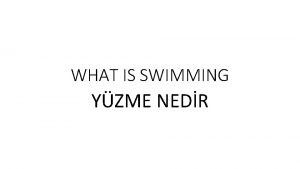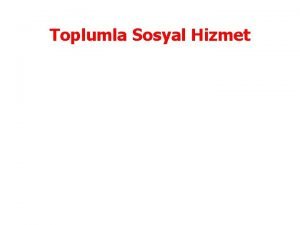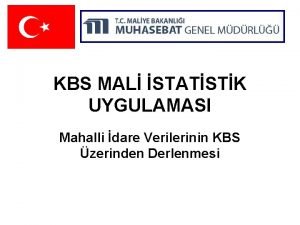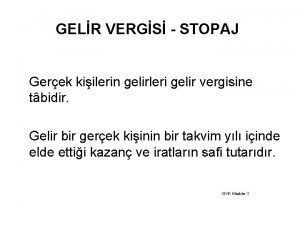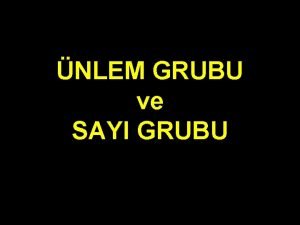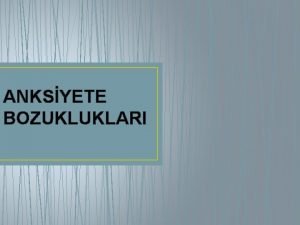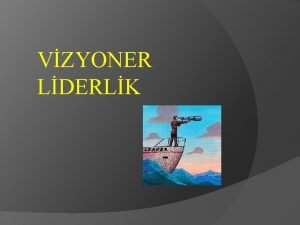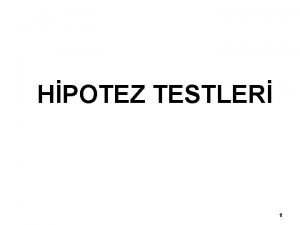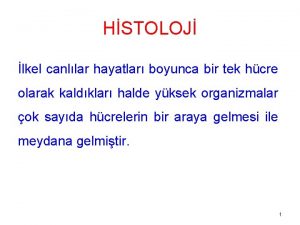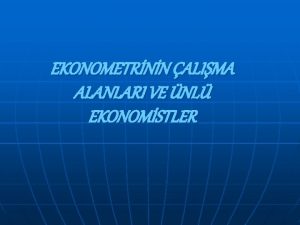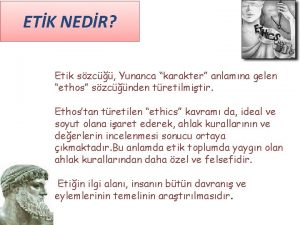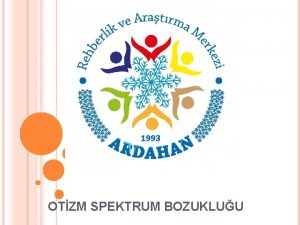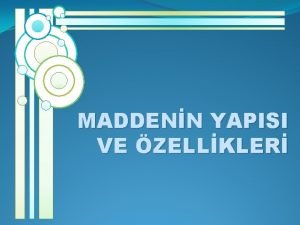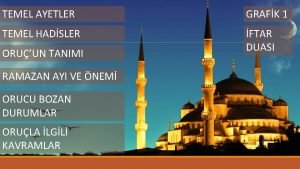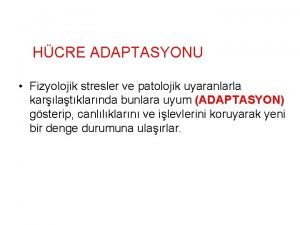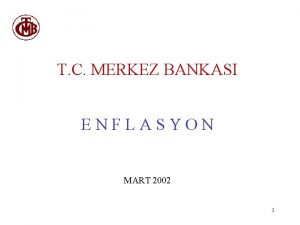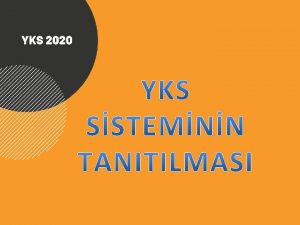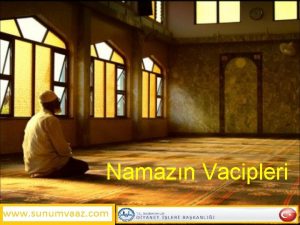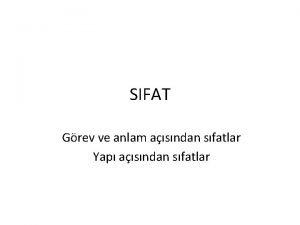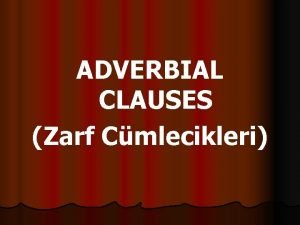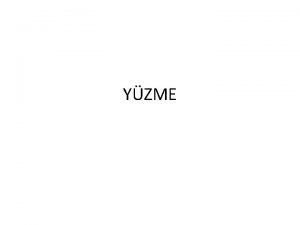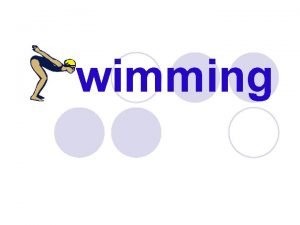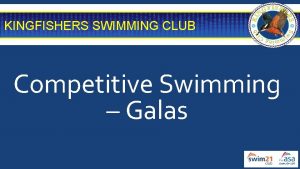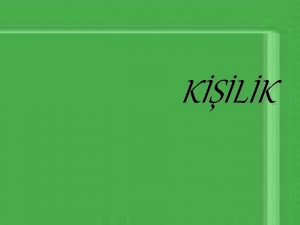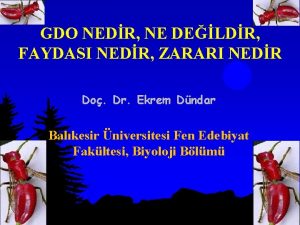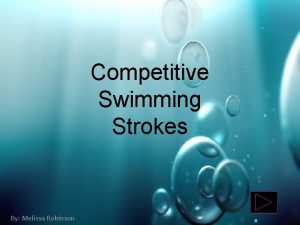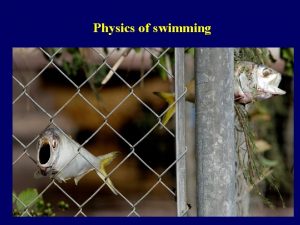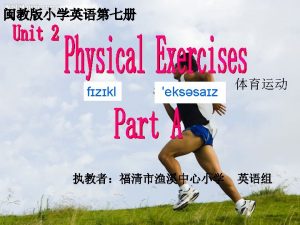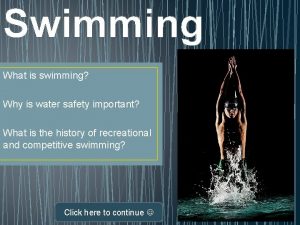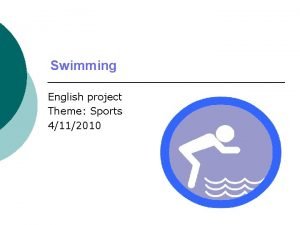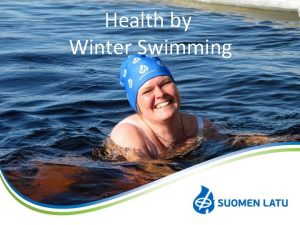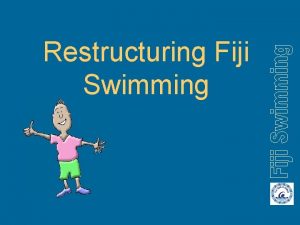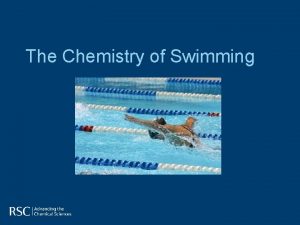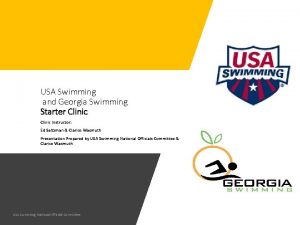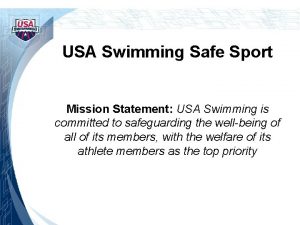WHAT IS SWIMMING YZME NEDR YZME yzmek er




























- Slides: 28

WHAT IS SWIMMING YÜZME NEDİR

YÜZME yüzmek, -er (I) 1. nesnesiz: Kol, bacak, yüzgeç vb. organların özel hareketleriyle su yüzeyinde veya su içinde ilerlemek, durmak: "Fakat bir gün onu denizde, şu mavi yeşil çizgilenen denizde yüzerken gördüm. " - Emine Işınsu 2. nesnesiz: Yüzme sporu yapmak. 3. nesnesiz: Bir sıvının yüzeyinde batmadan durmak: "Tahta suda yüzer. " 4. nesnesiz: Herhangi bir durumun en aşırı derecesinde olmak: "Hiçbir kaygının gölgelemediği bir saadet içinde yüzmektedir. " - Haldun Taner 5. nesnesiz, mecaz: Dalgalanmak. 6. nesnesiz, mecaz: Herhangi bir şeyle üzeri kaplanmak, bir şeye bulanmak: " Kitaplar toz içinde yüzüyor. Ev pislik içinde yüzüyor. " yüzmek, -er (II) 1. -i Derisini çıkarmak, derisini soymak. 2. -i, halk ağzında Çok para istemek. yüzme 1. isim Yüzmek işi. 2. isim Yüzme sporu. https: //sozluk. gov. tr/

SWIMMING to swim intransitive verb 1. a: to propel oneself in water by natural means (such as movements of the limbs, fins, or tail) b: to play in the water (as at a beach or swimming pool) 2. to move with a motion like that of swimming : GLIDE " a cloud swam slowly across the moon " 3. a: to float on a liquid : not sink b: to surmount difficulties : not go under " sink or swim, live or die, survive or perish "— Daniel Webster 4. to become immersed in or flooded with or as if with a liquid " potatoes swimming in gravy " 5. to have a floating or reeling appearance or sensation to swim transitive verb 1. a: to cross by propelling oneself through water " swim a stream " b: to execute in swimming 2. to cause to swim or float https: //www. merriam-webster. com/dictionary/swims

SWIMMING swim noun 1. a smooth gliding motion 2. an act or period of swimming 3. a temporary dizziness or unconsciousness 4. a: an area frequented by fish b: the main current of activityin the swim adjective : of, relating to, or used in or for swimming adjective 1. [present participle of swim] that swims a swimming bird 2. [gerund of swim] adapted to or used in or for swimming noun : the act, art, or sport of one that swims and dives https: //www. merriam-webster. com/dictionary/swimming

SWIMMING? SUBMARINE

BUYOANCY/YÜZERLİLİK buoyancy noun 1. a: the tendency of a body to float or to rise when submerged in a fluid "testing an object's buoyancy" b: chemistry the power of a fluid to exert an upward force on a body placed in it "the buoyancy of water" also: the upward force exerted 2. the ability to recover quickly from depression or discouragement : RESILIENCE "his buoyancy of spirit " 3. the property of maintaining a satisfactorily high level (as of prices or economic activity) " betting that the economy will maintain its buoyancy " Fb Wf ρ g V denotes the buoyant force applied onto the submerged object, denotes the weight of displaced fluid denotes the density of the fluid, is the acceleration due to gravity. represents the volume of the displaced fluid https: //www. merriam-webster. com/dictionary/buoyancy

BUYOANCY FLOATS SINKS SUSPENDS (at 4 °C and 1 atm pressure) + BUOYANCY - BUOYANCY 0 BUOYANCY

BUOYANCY OF HUMAN The composition of the human body is expressed in terms of elements: Element Oxygen Carbon Hydrogen Nitrogen Calcium Phosphorus Potassium Sulfur Sodium Chlorine Magnesium All others Symbol O C H N Ca P K S Na Cl Mg % mass 65. 0 18. 5 9. 5 3. 2 1. 5 1. 0 0. 4 0. 3 0. 2 0. 1 < 0. 1 % atoms 24. 0 12. 0 62. 0 1. 1 0. 22 0. 038 0. 037 0. 024 0. 015 < 0. 3 Zoroddu et al. (2019) The essential metals for humans: A brief overview. Journal of Inorganic Biochemistry 195(120 -129) (https: //doi. org/10. 1016/j. jinorgbio. 2019. 03. 013)

BUOYANCY OF HUMAN The composition of the human body is expressed in terms of chemicals: • Water • Proteins (including those of hair, connective tissue, etc. ) • Fats (or lipids) • Hydroxyapatite (in bones) • Carbohydrates (such as glycogen and glucose) • DNA • Dissolved inorganic ions (such as sodium, potassium, chloride, bicarbonate, phosphate) • Gases (such as oxygen, carbon dioxide, nitrogen oxide, hydrogen, carbon monoxide, acetaldehyde, formaldehyde, methanethiol. These may be dissolved or present in the gases in the lungs or intestines. Ethane and pentane are produced by oxygen free radicals. ) • Many other small molecules, (such as amino acids, fatty acids, nucleobases, nucleosides, nucleotides, vitamins, cofactors. ) • Free radicals (such as superoxide, hydroxyl, and hydroperoxyl. )

BUOYANCY OF HUMAN The composition of the human body can be viewed on an atomic and molecular scale The estimated gross molecular contents of a typical 20 -micrometre human cell is as follows Body composition can also be expressed in terms of various types of material, such as: Muscle Fat Bone and teeth Nervous tissue (Brain and nerves) Hormones Connective tissue Body fluids (blood, lymph, Urine) Contents of digestive tract, (including intestinal gas) Air (in lungs) Epithelium

BUOYANCY OF HUMAN Molecule Percent of Mass Mol. Weight (daltons) Molecules Percent Molecules Water Other Inorganics 65 1. 5 18 N/A 1. 74× 1014 1. 31× 1012 98. 73 0. 74 Lipids 12 Other Organics 0. 4 N/A 8. 4× 1011 7. 7× 1010 0. 475 0. 044 Protein RNA DNA N/A 1× 1011 1. 9× 1010 5× 107 46* 0. 011 3× 10− 5 3× 10− 11 20 1. 0 0. 1 Freitas, RA (1999) Nanomedicine. Vol. 1 Basic Capabilities. Landes Bioscience, p. 71 of

BUOYANCY OF HUMAN Water Fat Muscle Bone and teeth Air

BUOYANCY OF HUMAN Water Fat Muscle Bone and teeth Air

BUOYANCY OF HUMAN Water Fat Muscle Bone and teeth Air

BUOYANCY OF HUMAN Water Fat Muscle Bone and teeth Air

BUOYANCY OF HUMAN Water Fat Muscle Bone and teeth Air

BUOYANCY OF HUMAN Water Fat Muscle Bone and teeth Air

BUOYANCY OF HUMAN

Buoyancy Center of Buoyancy Weight Center of Weight Drag Thrust/Propulsion Dorchester Backwater by Mortimer Menpes, R. I. . Watercolor. http: //www. victorianweb. org/victorian/painting/menpes/wc/41. html

Buoyancy Center of Buoyancy Weight Center of Weight Drag Thrust/Propulsion Yacht "Savarona" (2008) Painting by Philippe Conrad (30 x 50 https: //www. artmajeur. com/en/philippeconrad/artworks/4631077/yacht-savarona

Buoyancy Center of Buoyancy Weight Center of Weight Drag Thrust/Propulsion Robert Norman Ross (October 29, 1942 – July 4, 1995) American painter, art instructor, and television host. He was the creator and host of The Joy of Painting, an instructional television program that aired from 1983 to 1994 on PBS in the United States, and also aired in Canada, Latin America, and Europe. https: //en. wikipedia. org/wiki/Bob_Ross

Buoyancy Center of Buoyancy Weight Center of Weight Drag Thrust/Propulsion The Front Crawl coloured pencils and solvent on paper · 30 x 23 cms http: //judithloganart. com/portfolio/paintings/pencils/

ADJUSTMENTS TO ZATSIORSKYSELUYANOV’S SEGMENT INERTIA PARAMETERS Paolo de Leva (1996) J. Biomechanics, Vol. 29 pp. 1223 -1230


Buoyancy Center of Buoyancy Weight Center of Weight Drag Thrust/Propulsion Dorchester Backwater by Mortimer Menpes, R. I. . Watercolor. http: //www. victorianweb. org/victorian/painting/menpes/wc/41. html

SUDA İLERLETİCİ KUVVETLER AYAK VURUŞU KOL ÇEKİŞİ

NEWTON’S FIRST LAW OF MOTION An object continues in a state of rest or in a state of motion at a constant velocity (constant speed in a constant direction), unless compelled to change that state by a net force. In the first law the phrase “net force” is crucial. Often, several forces act simultaneously on a body, and the net force is the vector sum of all of them. Individual forces matter only to the extent that they contribute to the total. When an object moves at a constant speed in a constant direction, its velocity is constant. Newton’s first law indicates that a state of rest (zero velocity) and a state of constant velocity are completely equivalent, in the sense that neither one requires the application of a net force to sustain it. The purpose served when a net force acts on an object is not to sustain the object’s velocity, but, rather, to change it. NEWTON’S THIRD LAW OF MOTION Whenever one body exerts a force on a second body, the second body exerts an oppositely directed force of equal magnitude on the first body. The third law is often called the “action–reaction” law, because it is sometimes quoted as follows: “For every action (force) there is an equal, but opposite, reaction. ”

BİZE GÖRE YÜZME • Su içinde iki nokta arasındaki mesafeyi en verimli şekilde gitmek. WATER SAFETY ILS STATEMENT ON WATER SAFETY EDUCATION AND DROWNING PREVENTION 1. Death by drowning is a leading public health problem in all countries. Prevention requires public and government support. 2. The vast majority of deaths by drowning can be prevented. 3. Everyone, ideally commencing at a young age and regardless of ability and background, should have access to training in water safety, personal survival and water rescue. 4. Knowledge and understanding of water environments and their associated hazards should be taught to everyone at the earliest possible age. 5. This awareness training should be accompanied by the provision of swimming teaching, in the safest manner possible and to at least a basic level of skill that provides the capacity for survival after unexpected and sudden immersion in water. 6. Acquisition of more advanced water safety knowledge and swimming skills, to include water rescue and competitive swimming, should be encouraged as these enhance aquatic safety. 7. Water hazards should be reduced wherever possible, particularly where swimming and water safety education take place. 8. Trained lifeguards should provide prevention, rescue and treatment where recreational swimming and water safety education take place. 9. Wherever possible, organizations with drowning-prevention expertise, based in high-income countries, should provide assistance to lower-income countries. 10. Accessible and affordable training in water safety and swimming skills should, ideally, be made available for everyone, particularly children, in all countries, to a level consistent with the ILS International Water Safety and Swimming
 Yzme
Yzme Saptama nedr
Saptama nedr Kbs mizan
Kbs mizan Gelr
Gelr Angka nedr juga termasuk angka
Angka nedr juga termasuk angka Edat nedr
Edat nedr Anksiyete nedr
Anksiyete nedr Vizyon nedr
Vizyon nedr Hipotez nedr
Hipotez nedr Sembolleştirme kapasitesi
Sembolleştirme kapasitesi Zekat nelerden ne kadar verilir
Zekat nelerden ne kadar verilir Homofobik nedr
Homofobik nedr şizogen boşluk
şizogen boşluk Ekonometr
Ekonometr Berat kandili nedr
Berat kandili nedr Edat nedr
Edat nedr Etik nedr
Etik nedr Otzm
Otzm Atom nedr
Atom nedr Imsak nedr
Imsak nedr Nekroz tipleri
Nekroz tipleri Enflasyon nedr
Enflasyon nedr Tyt nedr
Tyt nedr Vacip nedr
Vacip nedr Regip
Regip Hkaye
Hkaye Işaret sıfatı örnekleri
Işaret sıfatı örnekleri Panel nedr
Panel nedr Adverbial clause of reason
Adverbial clause of reason
